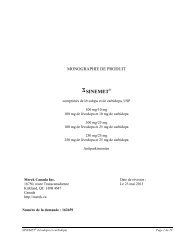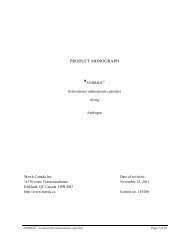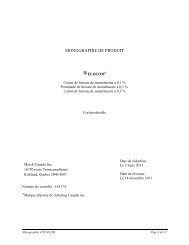1 PRODUCT MONOGRAPH - DVT ORGARAN Danaparoid Sodium ...
1 PRODUCT MONOGRAPH - DVT ORGARAN Danaparoid Sodium ...
1 PRODUCT MONOGRAPH - DVT ORGARAN Danaparoid Sodium ...
Create successful ePaper yourself
Turn your PDF publications into a flip-book with our unique Google optimized e-Paper software.
Platelets<br />
Platelet counts should be determined prior to commencement of therapy with <strong>ORGARAN</strong> ® and,<br />
subsequently, every other day during the first week, twice a week during the two weeks<br />
thereafter, and after three weeks once a week.<br />
Caution is recommended when administering <strong>ORGARAN</strong> ® to patients with congenital or drug<br />
induced thrombocytopenia, or platelet defects.<br />
Treatment of Patients with a History of (suspected) HIT<br />
Patients with a history of HIT should be tested for cross-reactivity with <strong>ORGARAN</strong> ® before<br />
routine <strong>DVT</strong> prophylaxis. If positive then <strong>ORGARAN</strong> ® should only be used if no other<br />
reasonable alternative is available. If under these circumstances <strong>ORGARAN</strong> ® is used, then the<br />
following clinical signs should be looked for as possible indications of clinical cross-reactivity:<br />
platelet count reduction (more than expected after surgery) and/or a thrombotic event. If either is<br />
noted then <strong>ORGARAN</strong> ® must be immediately discontinued and a laboratory test must be<br />
performed to look for evidence of an <strong>ORGARAN</strong> ® activated antiplatelet antibody (i.e. a positive<br />
cross-reactivity test). Only if the test is negative may <strong>ORGARAN</strong> ® prophylaxis be resumed if<br />
still necessary. Please refer to Product Monograph for <strong>ORGARAN</strong> ® - HIT.<br />
In exceptional circumstances, e.g. very high risk or heavy patients, it may be necessary to initiate<br />
<strong>ORGARAN</strong> ® prophylaxis with an i.v. bolus dose followed by subcutaneous dosing.<br />
Selection of General Surgery Patients: Risk factors associated with postoperative venous<br />
thromboembolism following general surgery include history of venous thromboembolism,<br />
varicose veins, obesity, heart failure, malignancy, previous long bone fracture of a lower limb,<br />
bed rest for more than 5 days prior to surgery, predicted duration of surgery of more than 30<br />
minutes, age 60 years or above.<br />
Elderly. Age is highly correlated to risk of thrombosis. No increased bleeding tendency has been<br />
10






